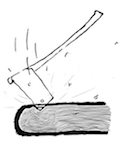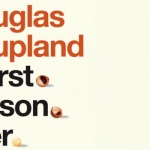Hatchet Job 2014 | Previous years | Manifesto | Press

Richard Evans on Hitler: A Short Biography by A.N. Wilson
THE NEW STATESMAN
FOLLOWING THE SUCCESS of his Booker Prize-longlisted novel Winnie and Wolf, a fictional account of the relationship between Hitler and the British-born wife of Siegfried Wagner, the composer’s son, A N Wilson has decided to publish a short biography of the German dictator. As writers of historical fiction do, he read a handful of English-language biographies and histories for his novel (he doesn’t appear to understand German) but he has added little or no further reading for this biography. What might do as background research for a novel won’t do as preparation for a serious work of history. Nor does he seem to have thought very hard or taken much care over what little reading he has done.
It would take more space than is available here to list all the mistakes in the book. Most obvious are the simple factual errors. The “Aryan race” in Nazi ideology was not “the Eurasian race”; it did not include “Slavs”, “Latins” or “Celts”. Hitler’s ideas did not include a “quasi-religious cult of violence based on a return to the mythologies of the pagan north” – pagan cults and mythologies were publicly condemned by Hitler in 1938. General elections were not “held on an almost monthly basis” in 1932; there were only two, in July and November. General Erich Ludendorff’s “prophecy” of the damage Hitler would cause once in power was invented later by the Nazi Hans Frank and has no basis in fact. Friedrich Reck-Malleczewen, author of the compelling Diary of a Man in Despair, was not “aristocratic” but the son of an innkeeper. Heinrich Brüning was not “leader” of the Catholic Centre Party but its parliamentary floor leader.
In the beer hall putsch of 1923, Hitler was not met by a hail of police bullets at the Bürgerbräukeller, where he launched the putsch, but at the Feldherrnhalle in the centre of town. Bavaria was not “separate from the rest of Germany until 1918″; it was a federated state, like Prussia or Baden.
There were not 750,000 “mixed-race” Jews in Germany in 1933; Wilson’s source for this grotesquely inflated number is a document quoted in Robert Gellately’s Backing Hitler but so hastily has he read Gellately that he hasn’t even bothered to note the sentence immediately following, which states that the document exaggerated the number and the real figure was about 85,000.
The number of Catholic priests imprisoned in the Dachau concentration camp was not 20,000 (this would have enormously exceeded the camp’s capacity) but, as noted in Stanislav Zamecnik’s standard work, 1,007 to the end of 1940 and another 2,720 to the end of the war. Thomas Mann’s novels were not publicly burned by the Nazis. The Hitler-Stalin pact did not allocate just German-speaking areas of Poland to German control – the vast majority of those who came under German occupation as a result of the pact were Polish or Yiddish speakers. Erwin Rommel was not a “man of the people” – his father was a headmaster and his mother an aristocrat. And so on, and so forth.
Wilson purveys many hoary myths long since discredited by historical research. Common sense, let alone a check of the secondary literature, should have shown him, for example, that the hyperinflation of 1923 did not destroy the middle classes, for while it rendered savings valueless, it also cancelled out mortgages and allowed businesses buying equipment on credit to get it for virtually nothing. Even more of a historical myth is what Wilson calls the “absolutely fundamental fact” that Hitler brought about a rapid recovery from the depression through “vast schemes of public works” such as “the building of the motorways” and thus “put Keynesianism into action”.
Economic historians have long since shown that these schemes were marginal and ineffective and unemployment continued at a high level until it began to be reduced by the introduction of mass conscription in 1935. Hitler was not a disciple of John Maynard Keynes; it was rearmament, not job-creation and public investment, that brought full employment. In common with many writers ignorant of German history, Wilson generalises repeatedly about “the German people” without differentiating between classes, religious denominations, regions, political orientations or gender.
There are many contradictions in the book’s arguments. He writes that Hitler “had none of the normal instincts of decency or kindliness” but we are also told that he “was habitually gentle with servants and secretaries”. He condemns speculation about what might have happened had the British and French tried to stop Hitler before it was too late, only to speculate at length, a few pages later, on “what would have happened if Chamberlain and Daladier had moved to help the Czechs” in 1938.
Repeatedly, he introduces material that is marginal or irrelevant, from the novels of Balzac and Thackeray to the reminiscences of Diana Mitford (who married the British fascist Oswald Mosley, though Wilson neglects to mention this).
Wilson remarks that Hitler belonged to “the oral future, the future which contained Walt Disney, television and cinema” but in reality he belonged to the oral past, to the world where mass rallies and speeches brought popular adulation to politicians such as William Gladstone or Keir Hardie. The future that Wilson describes is one of the visual image, though he says nothing about the Nazis’ disturbingly skilled use of it.
Some of his judgements are simply bizarre. He thinks the storm-trooper leader Ernst Röhm wanted revolution by “active homosexuality with street boys”. He doesn’t like dogs (“Hitler, in common with many dog-lovers, was incapable of showing the same affection for any human being such as that which poured out of him when feeding, or stroking, or staring into the eyes of this smelly near-cousin of the wolf”).
Wilson concludes with a series of reflections that are breathtaking in their banality. Hitler is “a mystery who cannot be plumbed”, “normal” and “ordinary” in his racism – a view that elides the huge gulf that separates casual, everyday racism from paranoid anti-Semitism to a degree that makes one realise that Wilson doesn’t understand Hitler’s anti-Semitism at all.
He claims that political correctness is based on doing the opposite to Hitler. “Hitler made homosexuals wear pink triangles, so we shall have gay marriages.” But he didn’t just make them wear pink triangles in the camps – he had them killed in large numbers – and the arguments that have legitimised gay marriages are different and have nothing to do with the horror of Nazism. His concluding warning, that a new Hitler might be lurking in the wings, ready to come out when the moment is right, shows that he understands nothing of the historical circumstances that brought Hitler to power.
It’s hard to think why a publishing house that once had a respected history list agreed to produce this travesty of a biography. Perhaps the combination of a well-known author and a marketable subject was too tempting for cynical executives to resist. Novelists (notably Mann) and literary scholars (such as J P Stern) have sometimes managed to use a novel angle of approach to say something new and provocative about Hitler, the Nazis and the German people. However, there is no evidence of that here, neither in the stale, unoriginal material, nor in the banal and cliché-ridden historical judgements, nor in the lame, tired narrative style; just evidence of the repellent arrogance of a man who thinks that because he’s a celebrated novelist, he can write a book about Hitler that people should read, even though he’s put very little work into writing it and even less thought.
This article originally appeared in The New Statesman on 12/03/12
Read all reviews for Hitler: A Short Biography by A.N. Wilson
The Omnivore on Twitter | The Omnivore on Facebook | Sign up for The Omnivore Digest









